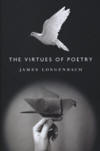The Virtues of Poetry
Critic and poet James Longenbach has a mission: to call writers back to the study of great poems. Although this mission has motivated Longenbach’s critical writing previously, it comes through most clearly in his newest book, The Virtues of Poetry, a series of twelve essays that each consider the qualities a successful poem might possess. Weaving together research, close reading, and unmitigated passion for the poems and poets he admires, Longenbach’s arguments prove convincing and insightful in this lively essay collection.
Critic and poet James Longenbach has a mission: to call writers back to the study of great poems. Although this mission has motivated Longenbach’s critical writing previously, it comes through most clearly in his newest book, The Virtues of Poetry, a series of twelve essays that each consider the qualities a successful poem might possess. Weaving together research, close reading, and unmitigated passion for the poems and poets he admires, Longenbach’s arguments prove convincing and insightful in this lively essay collection.
In the preface, Longenbach urges readers to move away from a manner-oriented approach that has led to writers “sequester[ing] themselves in one or another school room.” Instead, he counsels us to look at a poem’s virtues—a word he specifically uses with its older meaning of a “magical or transcendental power”—regardless of the poem’s particular school. Longenbach also chooses to look past more obvious poetic tools like the line, rhythm, meter, or sound, which he considered in The Resistance to Poetry, his 2004 collection of essays from The University of Chicago Press. Despite its title, The Resistance to Poetry argues that the technical aspects that make poetry a challenge ultimately constitute its wonder; in The Virtues of Poetry, Longenbach approaches matters less formally. Poetry’s virtues require more evocative terms such as precision, intimacy, shyness, excess. Longenbach works descriptively in The Virtues of Poetry, attempting to distill the potentially elusive qualities that make poems memorable.
Through anecdotes from poets’ lives and exuberant close readings, Longenbach illuminates his chosen virtues. Poems examined in the essays come from unsurprising choices easily recognizable by last name only: Shakespeare, Keats, Dickinson, Eliot, Pound, Yeats, Moore, Stevens, Bishop, Ashbery. Longenbach considered many of these same poets’ work (and the same poems) in The Resistance to Poetry, but even this repetition doesn’t detract from the persuasiveness of Longenbach’s readings. In part, his readings persuade because they engage with the poems honestly. For instance, after describing a passage from Eliot’s “The Dry Salvages” as “unacceptably leisurely” and “larded with unstressed syllables,” Longenbach doesn’t try to convince the reader that the poem succeeds in spite of these facts. Rather, Longenbach points out that, “Taken out of context, the passage may sound weirdly flat; in context, we experience the passage as an eschewal of artifice—an unexpected recovery of a world we thought we had to abandon in order to purchase the pleasure of art.” By approaching honestly the reader’s potential dismay, Longenbach allows us to experience his arguments as revelations, a natural outgrowth of deep consideration.
Many of The Virtues of Poetry’s most engaging and memorable passages are the anecdotes Longenbach relates about the lives of his chosen poets. He begins a chapter on doubt, presented through W.B. Yeats’s “The Second Coming,” by unexpectedly plunging the reader into the life of Georgie Hyde Lees Yeats: “The time is 1917, the place London. The war is on. You are a young woman, attractive, well-off . . .” Similarly, tensions between Emily Dickinson and her brother’s mistress embodied in a thank-you note enlivens the chapter about boldness in Dickinson’s poems, and scenes from the complicated friendship between Robert Lowell and Elizabeth Bishop provide an engrossing framework for a chapter about reticence and revelation in their work. Longenbach wants to draw our attention to the poems themselves, but he understands equally the appeal of work placed in context.
Packed with compelling close readings and attention-catching moments from poets’ lives, The Virtues of Poetry does much to prove that the poems we love merit careful attention, and that what makes them great might best be described in mysterious words like inevitability or otherness. The word “we” here is important: much could be argued against Longenbach’s too-familiar selection of poets, but his book doesn’t aim simply to elevate these poets and the particular virtues of their poems. Importantly, this collection maps out the route to discovering what each of us could define as virtues in the poems we love: spend time with the poem, reading and re-reading it until you’ve uncovered its magic, its own singular virtue. “Poems produce such rich and complicated effects with such extraordinarily limited means,” Longenbach writes. “What’s more, the effects are infinitely repeatable, a beauty born each time we take the journey from the first word of a poem to the last.” The Virtues of Poetry succeeds by teaching us to look for that beauty, and to look until we can name it.





